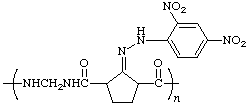
poly[imino(x-methyl-1,3-phenylene)iminomalonyl]
(benzene is senior to acyclic carbon chain; the path from N to N through the ring can go in either direction because of the absence of a specific locant for the methyl group; Rules 1, 11)
Continued with 10. References
Example 61

poly[imino(x-methyl-1,3-phenylene)iminomalonyl]
(benzene is senior to acyclic carbon chain; the path from N to N through the ring can go in either direction because of the absence of a specific locant for the methyl group; Rules 1, 11)

poly[oxyhexane-1,6-diyloxycarbonylimino(methylphenylene)iminocarbonyl]
(path between the two oxygens through the acyclic carbon chain is shorter, since for the benzene ring with unknown positions of its attachment to other atoms the longest possible path of four carbon atoms is being considered; Rule 15)

poly(2,4,8,10-tetraoxaspiro[5.5]undecane-3,9-diyloxyhexane-1,6-diyloxy)
(heterocyclic ring system is senior to heteroatoms; Rules 1, 12)

poly(pyridine-3,5-diylmethylenepyrrole-3,4-diyloxymethylene)
(pyridine is senior to pyrrole; shorter path; Rules 2d, 12)

poly(oxymethyleneiminocarbonylsulfanediyl-1,3-phenyleneethylene)
(O is senior to S; shorter path; Rules 4, 11)

poly(oxyiminomethylenehydrazine-1,2-diylmethylene)
(O is senior to N; shortest path between O and N; Rules 4)

poly(piperidine-4,2-diylmethylenepiperidine-4,2-diylcyclopentane-1,2-diylethylenecyclopentane-1,2-diylmethylene)
(shorter path between two identical senior heterocycles; shorter path from heterocycle to carbocycle; Rules 1, 11, 12, 15)

poly(oxymethyleneoxymethyleneiminoethylenesulfanediylmethyleneiminoethylene) or poly(1,3-dioxa-8-thia-5,10-diazadodecane-1,12-diyl)
(O is senior to S; shorter path from O to O to N; Rules 4, 15)

poly(oxymethyleneoxymethyleneoxymethyleneimino-1,3-phenylenemethyleneiminomethylene) or poly(1,3,5-trioxa-7-azaheptane-1,7-diyl-1,3-phenylene-2-azapropane-1,3-diyl)
(O is senior; the shorter path through all oxygens to the ring has been taken; Rules 4, 11, 16)

poly(pyridine-3,5-diyl-1,4-phenylenemethyleneoxymethyleneiminomethyleneoxy-1,4-phenylenemethylene)
(heterocycle is senior; shorter path from pyridine to benzene; Rules 1, 11, 12)

poly(sulfinylmethylenesulfanediylpropane-1,3-diylsulfonyl-1,4-phenylene)
(shortest path between the heteroatoms; Rule 16)

poly(oxyterephthaloylhydrazine-1,2-diylterephthaloyl)
(O is senior to N; Rule 4)

poly(nitrilo-1,4-phenylenenitriloprop-2-en-3-yl-1-ylidene-1,4-phenyleneprop-1-en-1-yl-3-ylidene)
(N is senior; shorter path between N; Rules 1, 15)

poly(oxycarbonylnitrilopropane-1,3-diylidenenitrilocarbonyl)
(O is senior to N; the direction of bonding in unsymmetrical nitrilo subunits, =N- or -N=, is indicated by the endings of the names of the adjacent subunits in the CRU; Rule 4)

poly(oxyethyleneiminomethylenesulfanediylethyleneiminocyclohexane-1,3-diyl)
(O is senior to S; shorter path; Rule 4, 11)
poly(1-oxa-6-thia-4,9-diazanonane-1,9-diylcyclohexane-1,3-diyl)

poly(iminomethyleneiminocarbonyl{2-[(2,4-dinitrophenyl)hydrazono]cyclopentane-1,3-diyl}carbonyl)
(either path through both N to ring; Rule 15)

poly(oxyterephthaloyloxyhexane-1,6-diyl)
(O is senior to benzene; shorter path between them; Rules 1, 1515)

poly(nitrilocyclohexa-2,5-diene-1,4-diylidenenitrilo-1,4-phenyleneimino-1,4-phenyleneimino-1,4-phenylene)
(-N= is most senior; Rule 7a)

poly(cyclohexane-1,4-diylmethanylylidenecyclohexane-1,4-diylidenemethanylylidenecyclo-hexane-1,4-diylmethylene)
(cyclohexane is most senior; the path to the next cyclohexane goes through a senior acyclic carbon atom -CH=; Rule 10a)